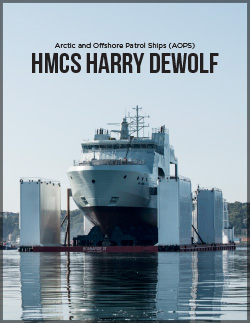By Anna Guy
In the Halifax Harbour in early October, 2018, hundreds of shipyard workers, navy members, shipbuilders and dignitaries gathered at the Irving Shipyard to christen HMCS Harry DeWolf.
Following Royal Canadian Navy traditions, Sophie Grégoire Trudeau was given the honour of breaking a bottle of champagne against the ship’s 103-metre long bow, presiding over the official naming of Canada’s first Arctic and offshore patrol ship, praising it for providing “capabilities that will benefit Canadians and the world.”
The future HMCS Harry DeWolf is the first of at least five Arctic and offshore patrol vessels tasked with patrolling Canadian waters, including the Arctic (construction on the future HMCS Margaret Brooke and HMCS Max Bernays is well underway), marking a significant milestone for the Arctic and Offshore Patrol Ship (AOPS) project and taking a step closer towards delivering these new ice-capable patrol ships to the Royal Canadian Navy (RCN).
The AOPS are specifically designed to include many features to allow
operation in the harsh Arctic climate where they will operate between July and October, providing greater and longer CAF presence in the North. “The ships were designed to Polar Class 5, enabling them to operate in medium first-year ice of 120-centimetre thickness, which may include old
ice inclusions,” says Geoff Simpson, Director General of Major Project Delivery for Sea. “They are also being constructed with high grades of steel with a maximum hull thickness of 43mm to allow operations in extreme arctic temperatures and ice. This will allow the Royal Canadian Navy to have unescorted access to areas of the Arctic that were previously inaccessible.”
The vessels will also incorporate other capabilities to allow the ship to operate independently in the Arctic such as ice-capable propellers, winterized lifeboats and robust de-icing features.
“The Harry DeWolf-class patrol ships will have the ability to sustain operations for up to four months. The Nanisivik Naval Facility and our future support ships will further extend the RCN operations by refueling and replenishing the ships,” says Simpson.
“By design, the Arctic and Offshore Patrol ship can embark a variety of payloads as well as embark and support specialized teams of personnel to meet the wide variety of missions as required by the Government of Canada. Able to operate with helicopters from the Royal Canadian Air Force, Coast Guard or contracted through offshore services, the Arctic and Offshore Patrol Ship is perfectly suited to undertake all of the tasks previously mentioned, enabling partners in their pursuit of missions assigned.”
Future Generations
Canada possesses a vast maritime estate—it has the world’s longest coastline, the second largest continental shelf, and the fifth largest Exclusive Economic Zone in the world. The AOPS will provide security in international operations such as anti-smuggling, anti-piracy, international security, artic sovereignty, as well as contribute to humanitarian assistance, emergency response and disaster relief in domestically or internationally—in fact, its primary mission while operating in Canada’s North will be surveillance and securing Canada’s Arctic Sovereignty in collaboration with other Government Departments and Canada’s Arctic partners.
“The multi-purpose nature and versatility of this ship, both independently and as part of an allied or coalition Task Force, allows Canada to rapidly deploy credible naval forces worldwide, on short notice,” says Simpson. “This calls for naval forces that are designed and structured to operate in some of the most extreme ocean conditions. Further, since a large part of Canada’s prosperity relies on the maintenance of free and open access to international waters for trade and commerce, Canada requires a navy that is organized and sized to project Canadian values and interests responsively and effectively far from Canada’s shores.”
Principal among the challenges at home is the need to operate in the Arctic, alongside the Canadian Coast Guard, and alongside allied partners, says Simpson. “Key to this is the Arctic and Offshore Patrol Ship project, which is part of the National Shipbuilding Strategy and involves the delivery of five to six ice-capable ships to the Royal Canadian Navy.”
AOPS will provide sea-borne surveillance of Canadian waters, including in the Arctic. They will enforce sovereignty, cooperating with partners, at home and abroad, and will provide the Government of Canada with
awareness of activities in Canada’s waters.
Benefits on Land and Sea
The Government is delivering on its commitment to renew the fleets of both the Royal Canadian Navy and the Canadian Coast Guard, to revitalize the Canadian marine industry and create jobs and opportunities for hard working middle-class Canadians.
As reported in the recently released Canada’s National Shipbuilding Strategy: 2017 Annual Report, contracts awarded between 2012 and 2017 through the National Shipbuilding Strategy will contribute close to $8.9 billion of gross domestic product and approximately 8,800 jobs per year, on average, will be created or maintained between 2012 and 2022.
“In addition, there has also been significant economic benefits to Canada through the application of Canada’s Industrial and Regional Benefits (IRB) Policy, which requires the shipyards and their major suppliers to undertake business activities in Canada equal to the value of the contracts they are awarded by the Government of Canada,” says Jessica Lamirande, Senior Communications Advisor, Media Relations Office, DND.
Beyond the two primary shipyards, significant opportunities are available for Canadians and Canadian suppliers. Contracts are being issued by both the Government and shipyards to hundreds of firms across Canada, including a significant number to Small and Medium-sized Enterprises.
The National Shipbuilding Strategy is working to support jobs and economic opportunities for Indigenous and underrepresented groups in the shipbuilding industry. The two selected shipyards have executed contracts with Indigenous firms, and through their National Shipbuilding Strategy Value Proposition investments, the shipyards have developed and are delivering programs to provide associated training and apprenticeship opportunities to support women and Indigenous Peoples.
Says Simpson, “The Strategy is a long-term commitment to shipbuilding that will revitalize our marine industry, support Canadian technological innovation, and bring jobs and prosperity to many communities across the country.”







